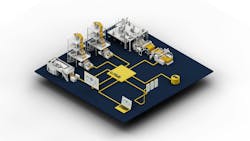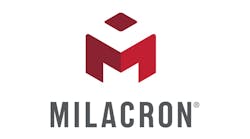By Bruce Geiselman
A shortage of skilled workers is helping fuel demand among plastics processors for equipment that includes artificial intelligence (AI), process monitoring and other digital technologies.
AI and process monitoring also can help improve product quality and reduce costs due to less waste. In some cases, AI can automatically detect emerging problems and adjust processing parameters without worker intervention.
Colines AI assistant makes managing lines easier
During NPE2024, Colines demonstrated its latest AI product by equipping an AllRollEx cast extrusion line for stretch film with the company’s Mastermind AI virtual production assistant.
The company ran demonstrations producing seven-layer pre-stretch film.
Mastermind automates many of the most time-consuming tasks, which simplifies operation, reduces set-up and start-up times, ensures production quality, and allows less-experienced operators to easily manage film extrusion lines, according to the company.
“It’s able to help operators run the machine,” said Gabriele Peccetti, Colines marketing and communications director and sales area manager. “Just push one button, and the line in 20 seconds can go to the target with very low tolerance of the thickness and without touching the die. … It recognizes the variation of necking of the film without touching anything.”
Mastermind ties directly into the HMI control panel of a Colines extrusion line and automates die adjustments, resulting in a “completely touchless flat die” with no more need for manual adjustment of the die bolts, according to the company. An automatic sizing feature changes the reel size without halting the extrusion line. In addition, interfacing Mastermind with MES Live Control, another Colines product, allows for advanced data analysis and production monitoring, according to the company.
Mastermind currently works with cast film lines, but the company plans to develop the technology for blown film production as well, Peccetti said.
AI technology is becoming increasingly important to film extruders as many companies struggle to hire skilled operators.
“What we are trying to do at Colines is optimize the machine as much as we can,” Peccetti said. “We want to help our customers not only speed up the setup of the line, but also avoid any mistakes during the production, night and day, and try to eliminate problems when you change operators.”
Mastermind improves worker safety since it reduces the need for operators to physically work on the extrusion line, according to the company.
Reifenhäuser offers brand-agnostic digital platform
At NPE, Reifenhäuser, a manufacturer of extrusion lines and components, highlighted its digital platform that allows plastics processors to collect, manage and analyze data from their primary processing equipment and peripheral devices, regardless of their machines’ manufacturer, age or type.
RE: GmbH, a wholly owned subsidiary of Reifenhäuser, demonstrated its digital platform for monitoring and managing data from Reifenhäuser and third-party systems.
“We want to focus on digitalizing your whole shop floor instead of just Reifenhäuser assets,” said Lisa Hallmann, a RE: senior customer success manager. “Our overall goal is to connect the data from all your lines, no matter which vendor, to one central system and make data available for you to make better business decisions, reduce scrap, increase efficiency, gain transparency and reduce costs in the long term.”
Reifenhäuser’s digital solution for companies in the extrusion and packaging industry consists of two components: c.Hub, a middleware (software) system that connects all assets, peripheral devices and primary processing equipment regardless of vendor, age or type; and ExtrusionOS, software that allows for the display of collected data on user-friendly dashboards and for monitoring, storing and analyzing the data.
“We get all the data coming from your assets, and we make it available in the application,” Hallmann said. “In this application, we just provide you with real-time data and an archive of your data that you can use and work with, and trends. We also provide you with customized analytics on certain topics like energy, carbon footprint, and we give you a good overview of your general line. It helps you to understand better what is happening on your line.”
A processor can grant access to employees to view the collected data from anywhere, gaining new insights into production and its challenges.
Monitoring allows operators to react quickly to changing process parameters to maintain product quality and prevent production of scrap or waste parts or materials.
“We will send you notifications to understand and react on time instead of once it’s already too late,” Hallmann said.
The company’s digital platform can help minimize unplanned equipment downtime and the associated costs, Hallmann said.
Downtime Manager, a feature of ExtrusionOS, allows production managers and machine operators to capture and analyze downtime in the production environment. With the help of Downtime Manager, they gain insights that enable them to improve error analysis and reduce downtime, ultimately leading to increased overall equipment effectiveness.
By eliminating the need for operators to write down data on paper, data accuracy is significantly increased, according to the company. Operators and production managers assign categories to downtime instances in ExtrusionOS. They can do this categorization on the spot, for example via a tablet, to ensure real-time documentation.
“As far as I know from my customers, it used to be a very manual process where the operator was writing down when the line was down and then linking a reason to it,” Hallmann said. “Obviously, a lot of mistakes can happen during this process because you have different priorities when the line is down than writing down when it was down.”
Downtime Manager also can generate comprehensive reports that analyze various aspects of downtime. These include, for example, the number and duration of downtime incidents and the frequency of downtime by category and other available metrics.
The software also can work with a customer’s existing ERP and MEP software.
Collin film inspection system detects flaws
Collin Lab & Pilot Solutions GmbH, based in Germany, demonstrated at NPE a new film inspection system with a practical post-processing tool.
The Collin FI film inspection system is designed for continuous film defect inspection. The inspection system can be used on a flat or blown film line. An LED light source and line camera are installed before the take-off rolls, meaning defects can be detected and evaluated before the film is dispersed. The inspection system, which includes Collin software, can detect optical defects including contaminants such as black spots or pigment agglomerates in pigmented films. Numerous adjustments are possible for the error parameters, and an online display of the results of running tests are available.
The FI inspection system uses a graphics card instead of a frame grabber card. The result is the ability to analyze, record and store video as well as still frames.
“We are faster in processing and using less in resources of the computer in the background,” said Gernot Schaffler, head of process engineering at Collin. “We can process and analyze the data much quicker than before.”
The FI inspection system stores inspection video for possible future analysis with a different post-processing algorithm, which was not possible with an older system, Schaffler said.
Bruce Geiselman, senior staff reporter
[email protected]
Colines USA Corp., Hauppauge, N.Y., 631-521-7528, www.colines.it
Collin Lab & Pilot Solutions Inc., Tucker, Ga., 678-325-6708, www.collin-solutions.com
RE: GmbH, Cologne, Germany, [email protected], www.re-digital.io
Reifenhäuser Inc. (Reiloy USA), Maize, Kan., 316-260-2122, www.reifenhauser.com b
Bruce Geiselman | Senior Staff Reporter
Senior Staff Reporter Bruce Geiselman covers extrusion, blow molding, additive manufacturing, automation and end markets including automotive and packaging. He also writes features, including In Other Words and Problem Solved, for Plastics Machinery & Manufacturing, Plastics Recycling and The Journal of Blow Molding. He has extensive experience in daily and magazine journalism.
Nordson names regional sales manager
Guill Tool hires new sales representative
PTi names Ryan Pasturczak sales manager






